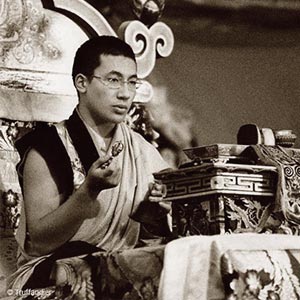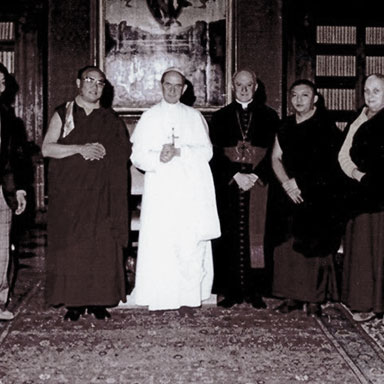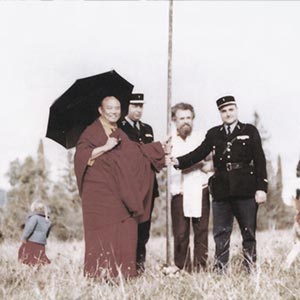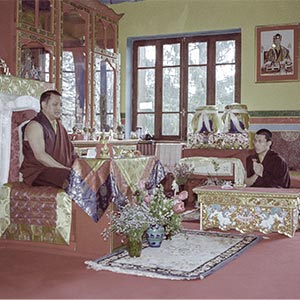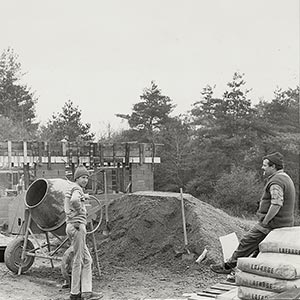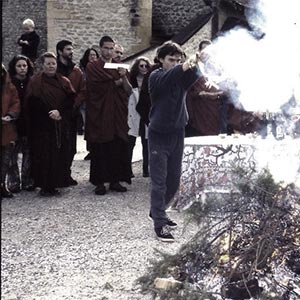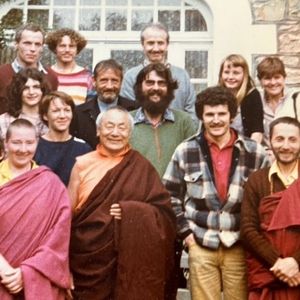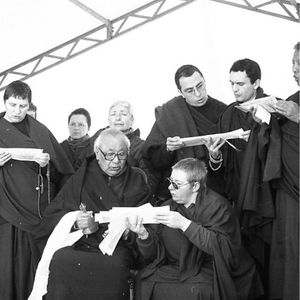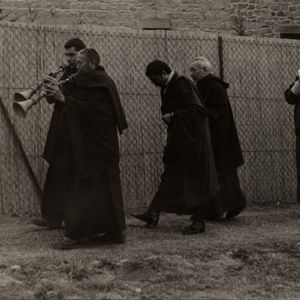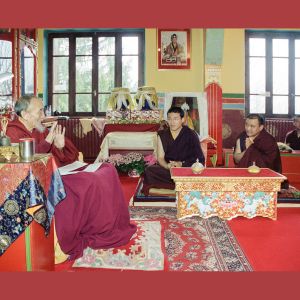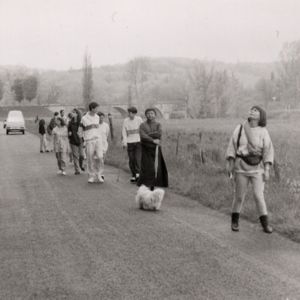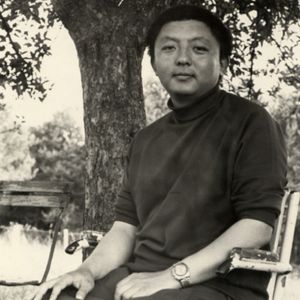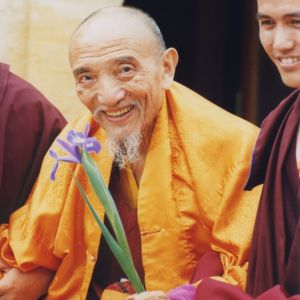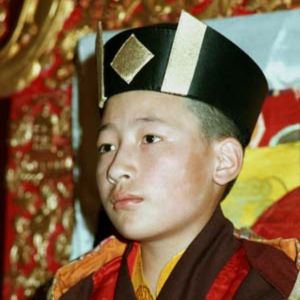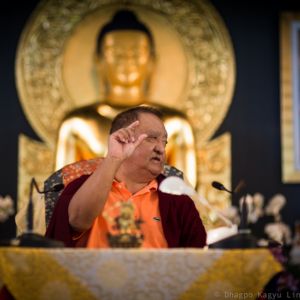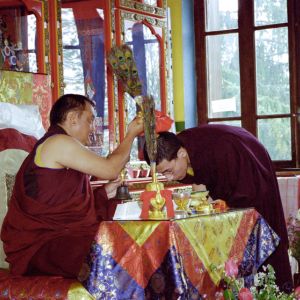The 2nd Gyalwa Karmapa, Karmapa Pakshi (1204–1283), indicated that he would manifest in the future in two physical forms that would be one in essence: the Black Crown Karmapa and the Red Crown Karmapa, otherwise known as the Shamarpa.
།བསྐལ་མང་གང་ནས་ཚོགས་གཉིས་རོགས་མཛད་ཅིང་།
མཐའ་ཡས་སེམས་ཅན་ཚོགས་རྣམས་སྒྲོལ་བ་ལ།
ཕྲིན་ལས་འདོད་དགུའི་སྒྱུར་ལ་མངའ་བརྙེས་པའི།
ཞྭ་དམར་ཅོད་པན་འཛིན་པ་རྣམས་ལ་འདུད།
ཀརྨ་པ་མི་བསྐྱོད་རྡོ་རྗེའི་གསུངས།
To the one who for many eons has strived to facilitate the two accumulations
That liberate the infinity of sentient beings,
To the master whose enlightened activity fulfills all desires,
To the holder of the Red Crown, I pay homage.
The 8th Gyalwa Karmapa, Mikyö Dorje
Our narrow perception can only touch the surface of what the Karmapas and Shamarpas truly are. Our field of experience is limited to terms whose full extent we can’t really grasp—holder of the Red Crown; holder of the Karma Kagyü lineage—and to the physical presence in our world of these manifestations of enlightenment.
From 1981, Mipham Chökyi Lodrö, His Holiness the 14th Künzig Shamarpa, came at least once a year to Dhagpo Kagyu Ling and “took care to offer the nectar of the Buddha’s words and methods so that practitioners could journey on the path towards liberation,” writes Lama Jigme Rinpoche in his foreword to Shamarpa’s recently published work, Insight through Learning, Reflecting and Meditation: The Fourfold Application of Mindfulness.[1]
This work presents a teaching that Shamarpa gave at Dhagpo Kagyu Ling in 2006, based on The Dharma Discourse on Defining the Topics (Arthaviniścaya Dharmaparyāya), a text considered to be a discourse or sutra taught by Buddha Sakyamuni.
In 2014, Künzig Shamarpa once again gave a teaching at Dhagpo Kagyu Ling on the four applications of mindfulness, in the Institute that he had inaugurated the previous year. It was to be his last teaching at the European center of the Karma Kagyü lineage.
Less than three weeks after this May 24 and 25 teaching, Kunzig Shamarpa entered parinirvana on June 11, 2014, at the Bodhi Path center in Renchen Ulm, Germany. He was intent on transmitting authentic Buddhist teachings adapted to our times, so that practitioners could acquire an understanding of the nature of mind and accomplish their own wellbeing and that of others.
“The subject of the fourfold application of mindfulness is an extremely important one, no matter what approach we follow in Buddhism,” explained Künzig Shamarpa at the beginning of the teaching.
Over these two days, Künzig Shamarpa stressed the need to cultivate a stable and calm abiding mind, by focusing with vigilance and awareness – namely by being aware of one’s state of mind, seeing distraction and remembering the exact antidote to apply when it arises.
Our aim in meditation is to acquire peace of mind. If you have acquired a peaceful mind, this peace no longer depends on any outer condition. […] If you don’t have this stability, no matter how much you meditate on these four applications, these meditations won’t be effective. It is absolutely necessary that you first succeed in acquiring a stable mind.
Through observation, analysis and contemplation, Künzig Shamarpa explains that we can reach understanding that the body, sensations, phenomena and mind have no ultimate substance, no intrinsic existence, and gain an accurate understanding of their true reality. “There is inherent suffering, because we are associated with this body. The mind is like imprisoned in the body because of our appropriation of the body. Our constant grasping leaves no room for freedom. This constant and subtle suffering is like the paving of a road,” explains Shamarpa. We must observe the continuum of mind and the present moment of consciousness.
Try to see the mind as it is, in its fundamental nature, dissociated from all the concepts that it grasps and perceives. You will see that there is nothing to grasp and come to recognize the mind as it is.” To this end, Shamarpa once again returned to the importance of shine meditation to acquire a stable mind and greater discernment. “You must meditate like a horse grazes grass. As soon as you have the time, do it and you will succeed.
This last teaching took place in the presence of the Buddha’s relics, usually kept at the Grande Pagode du Bois de Vincennes (on the outskirts of Paris) and that arrived at Dhagpo Kagyu Ling in November 2013. At the end of the teaching, Kunzig Shamarpa rose, started to push his chair to one side to sit on the floor, on a cushion in meditation posture, facing the Buddha’s relics. From here, he gave refuge and blessed all practitioners present, while reciting The King of Aspiration Prayers of Samantabhadra.
The 14th Kunzig Shamarpa was born on the day when Buddha Sakyamuni set the wheel of Dharma in motion; he left this incarnation the day that we celebrate the birth, awakening and parinirvana of the Buddha.
During a private meeting, Thaye Dorje, His Holiness the 17th Gyalwa Karmapa said:
I don’t think anyone really recognizes the undifferentiated aspect of the late Rinpoche and the 16th Karmapa.
[1] Shamar Rinpoche. Insight through Learning, Reflecting, and Meditating : The Fourfold Application of Mindfulness. Rabsel Éditions. La Remuée, France, 2025.
These photos come from our archives or were collected as part of the research for Dhagpo Kagyu Ling’s 50th anniversary. We have not been able to identify all the authors. The use of these photos is solely for informational purposes within the context of Dhagpo Kagyu Ling’s 50th anniversary celebration. Their use is limited to this event and our website and is not for commercial purposes.
Event
This event will be commemorated by the screening of Künzig Shamarpa’s last teaching at Dhagpo Kagyu Ling on the fourfold application of mindfulness.
![]() This event takes place in Dhagpo Kagyu Ling’s Institute. It will be screened online and translated into several languages (English, Spanish, German, Russian).
This event takes place in Dhagpo Kagyu Ling’s Institute. It will be screened online and translated into several languages (English, Spanish, German, Russian).
These photos come from our archives or were collected as part of the research for Dhagpo Kagyu Ling’s 50th anniversary. We have not been able to identify all the authors. The use of these photos is solely for informational purposes within the context of Dhagpo Kagyu Ling’s 50th anniversary celebration. Their use is limited to this event and our website and is not for commercial purposes.



